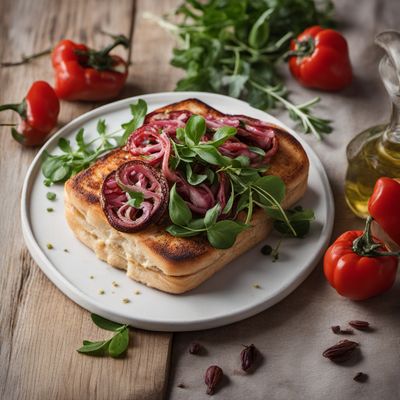
Ingredient
Soft-ripened cheese with natural rind and other soft-ripened cheeses
Velvety Delights: Exploring Soft-Ripened Cheeses
Soft-ripened cheese with natural rind and other soft-ripened cheeses are characterized by their soft and creamy textures, often accompanied by a bloomy or wrinkled rind. These cheeses have a rich and buttery flavor profile, sometimes with earthy or mushroom-like undertones. They are best enjoyed when allowed to ripen at room temperature, resulting in a luscious and indulgent cheese experience.
Origins and history
Soft-ripened cheeses have a long history dating back to medieval times in Europe. They were traditionally made by monks in monasteries, who discovered the art of ripening cheese to perfection. Soft-ripened cheeses gained popularity over the years and are now produced in various regions worldwide, each offering its unique twist on this beloved cheese style.
Nutritional information
Soft-ripened cheeses are a good source of calcium, protein, and essential vitamins. They are also rich in saturated fats, so moderation is key when enjoying these indulgent cheeses. The nutritional content may vary depending on the specific cheese and its ingredients.
Allergens
Soft-ripened cheeses may contain allergens such as milk and dairy products. Individuals with lactose intolerance or dairy allergies should exercise caution and consult with a healthcare professional if necessary.
How to select
When selecting soft-ripened cheese with natural rind and other soft-ripened cheeses, look for cheeses that are plump and slightly firm to the touch. Avoid cheeses with any signs of mold or excessive softness, as these may indicate spoilage. The rind should be intact and free from any cracks or discoloration. Opt for cheeses that have a pleasant aroma, without any off-putting smells.
Storage recommendations
To maintain the freshness and quality of soft-ripened cheese with natural rind and other soft-ripened cheeses, store them in the refrigerator at a temperature between 35-45°F (1-7°C). Keep the cheese wrapped in wax or parchment paper to allow it to breathe and prevent moisture buildup. Bring the cheese to room temperature before serving to fully appreciate its flavors and textures.
How to produce
Soft-ripened cheeses with natural rind and other soft-ripened cheeses can be produced by artisanal cheesemakers or even by enthusiasts at home. However, the process requires specific knowledge and equipment to ensure proper ripening and aging. It is recommended to start with simpler cheese recipes and gradually progress to more complex ones.
Preparation tips
Soft-ripened cheeses with natural rind and other soft-ripened cheeses can be enjoyed on their own, accompanied by crusty bread, fresh fruits, or honey for a delightful cheese platter. They are also excellent for melting, making them a perfect choice for grilled cheese sandwiches, quiches, or creamy pasta dishes. Experiment with pairing soft-ripened cheeses with wines, such as Chardonnay or Champagne, to enhance the overall tasting experience.
Culinary uses
Soft-ripened cheese with natural rind and other soft-ripened cheeses are widely used in various culinary applications. They are commonly enjoyed on cheese boards, in sandwiches, salads, or as a topping for pizzas. Soft-ripened cheeses also add a luxurious touch to gourmet recipes, such as soufflés, tarts, or risottos.
Availability
Soft-ripened cheese with natural rind and other soft-ripened cheeses are produced in different regions worldwide. France, particularly the regions of Brie and Camembert, is renowned for its soft-ripened cheeses. Other countries like the United States, Italy, and Switzerland also produce their versions of these velvety delights.
More ingredients from this category
Recipes using Soft-ripened cheese with natural rind and other soft-ripened cheeses » Browse all

Grilled Octopus Panino
Mediterranean Delight: Grilled Octopus Panino

Grilled Octopus Salad
Mediterranean Delight: Grilled Octopus Salad with Zesty Citrus Dressing

Georgian Twinkie Delight
Kartuli Twinkie: A Georgian Twist on a Classic American Treat

Macedonian Octopus Salad
Mediterranean Delight: Macedonian Octopus Salad

Chilean-style Pulpo Nigiri Sushi
Marinated Octopus Delight: Chilean-style Pulpo Nigiri Sushi

Muhajir-style Spicy Octopus Salad
Fiery Fusion: Muhajir-style Spicy Octopus Salad

Grilled Octopus with Lemon and Herbs
Savour the Sea: Grilled Octopus Delight

Georgian-inspired Cheesy Potato and Pasta Bake
Kartopili Khachapuri - Georgian Cheesy Potato and Pasta Bake

Georgian-inspired Spinach and Cheese Frittata
Savory Spinach and Cheese Delight: A Georgian Twist on Frittata

Faroese-style Octopus Fillets
Oceanic Delight: Faroese-style Octopus Fillets

Portuguese Linseed Octopus
Oceanic Delight: Portuguese Linseed Octopus

Drunken Octopus Stew
Seafood Delight: Drunken Octopus Stew